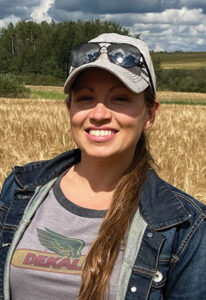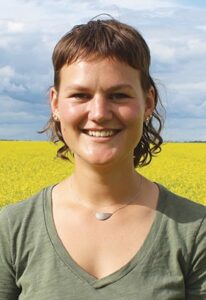Market Signals
Our farmer panelists share their approaches to canola marketing: What signals and fundamentals do they watch for, how do they get market information, and whose advice do they follow?
 Melissa Damiani
Melissa Damiani
Bluffton, Alberta
Melissa Damiani is honest about her marketing skills: “I have my strengths and passions when it comes to farming, but marketing is not one of them,” she says.
“Why struggle through something you dislike or aren’t good at?”
“I have my strengths and passions when it comes to farming, but marketing is not one of them. Why struggle through something you dislike or aren’t good at?”
–Melissa Damiani
Her advice to self: Don’t be afraid to ask for help. Marketing advisors can reduce some pressure and help with decisions. “If you can find someone you trust that understands your business, your challenges and your goals, that is worth something,” she says.
Various factors feed into their marketing plan. Crop rotation is one. “I would like to grow more oats but we just don’t have the bin space.” They don’t do a lot of pre-selling because results are so unpredictable in their area. “It seems like early frost, snowstorms, late hail or other weather difficulties are regular occurrences. I have to be careful not to over-commit on sales or contracts,” she says. “We are fortunate to live in a big feed market where silage and green-feed are definitely options. This can be especially useful on a hail year.”
They set target selling prices based on fixed and variable costs of production, and make decisions based on cashflow and logistics.
“We know what bills we have coming due, and sometimes have to factor our sales into those timeframes so we can keep those commitments,” she says. And because they both work off-farm jobs and the bin yard “isn’t exactly what we would like,” timing and labour are factors for hauling grain. “We have to make sure we don’t need a winch truck to haul grain in and out of the yard if the ground is soft.”
 Fiona Jochum
Fiona Jochum
St. Francois Xavier, Manitoba
Fiona Jochum sells based on two math-based thresholds. Threshold one: the price covers their cost of production. This requires accurate calculation of all costs. Threshold two: the price improves on the previous crop year. This requires accurate record-keeping of historic sales. If selling prices don’t exceed threshold two, they should at least meet threshold one.
“Ideally, we want to get five per cent better every year – within reason. …
In 2020, a five per cent increase over 2019 wasn’t good enough.”
–Fiona Jochum
“Ideally, we want to get five per cent better every year – within reason,” Jochum says. Sometimes market situations make it impossible to get a better price. Sometimes the five per cent increase doesn’t require any marketing skill or strategy at all. “In 2020, a five per cent increase over 2019 wasn’t good enough,” she says. The same would be true for 2021 versus 2020. Statistics Canada’s database shows average canola selling prices of $510.86 for the 2019-20 crop year, $640.73 for the 2020-21 crop year, and $912.80 for the 2021-22 crop year.
With their goals in mind, Jochum and her father, who farm together, have daily discussions over morning coffee to talk through the market situation. The basic strategy is to sell incrementally throughout the year – “a few truckloads at a time when prices meet our goals,” she says.
Incremental selling means they don’t have to guess market highs for the year. “There is so much information and yet no one really knows where the market is going,” Jochum says. “Even when global weather suggests that markets should go up, they don’t always go up.” The Jochums subscribe to two marketing newsletters, DePutter and GrainFox, that provide strategies for incremental selling.
“We don’t sell on a rigid schedule,” Jochum says. Each day they talk about market fundamentals, news, market updates from grain buyers, and advice from DePutter and GrainFox. They check how the price of the day lines up with their targets, and decide whether to sell. They also forward-sell 15 to 20 per cent of their anticipated yield each year, taking advantage of good pricing opportunities through the previous winter and spring.
 Josh Heidt
Josh Heidt
Kerrobert, Saskatchewan
Josh Heidt uses marketing trends to his advantage. He aims to sell more grain in the spring and summer when demand can start to exceed supply and prices often increase. “So many try to move grain off the combine for reasons of limited storage capacity, storage risk and bill payments,” he says. “We want to hold off until later when shorter supplies create opportunities. It means more risk but higher upside.”
The Heidts invested $60,000 to $70,000 in BinSense a couple years after losing 10,000 bushels.
“Now we don’t have to physically check bins.”
–Josh Heidt
Increased risk with this strategy often comes down to storage, Increased risk with this strategy often comes down to storage, particularly for canola, a crop that can spoil and burn if grain is too moist, too hot, too green or has higher levels of dockage. “We lost 10,000 bushels of canola five years ago,” Heidt says. “There is nothing worse that losing grain in storage, especially when you’ve gone through all the trouble to get it there.”
So how does he mesh this storage disaster with a marketing strategy that depends on safe long-term storage? With a BinSense system. The system includes cables to measure grain temperatures in all bins and, more importantly, continuous automatic monitoring through a central hub. The system alerts Heidt through his phone when it detects unexpected temperatures. Stopping spoilage early can save the bin from grade loss. The Heidts invested $60,000 to $70,000 in BinSense a couple years after losing the 10,000 bushels. “Now we don’t have to physically check bins,” he says. Checking canola bins every month isn’t good enough to save a bin if it starts to heat, and cables without the automatic monitoring system need to be read one at a time with a hand-held monitor. BinSense provides regular monitoring and automatic alerts. “What’s easier than that?” he says.
For market information, Heidt tries to focus on fundamentals, including weather-influenced production around the world, that can change the global supply and demand situation. “We want to block out the noise of daily jumps and falls,” he says. They subscribe to FarmLink’s marketing newsletter for fundamentals-based advice. “This information helps us base decisions on actual numbers, not gut feel.”
 Murray Lewis
Murray Lewis
Cleardale, Alberta
Before harvest 2022 even began, Murray Lewis had already sold some 2023 canola. “When prices are good, I want to be selling some.”
–Murray Lewis
Murray Lewis often starts selling
a year in advance of harvest. Before harvest 2022 even began, he had already sold some 2023 canola. He did the same for this year’s crop, pre-selling part of his anticipated yield over a year ago. “When prices are good, I want to be selling some,” he says.
His primary source of marketing advice is MarketSense from Cargill. “I don’t want marketing to be my job, so I enrolled in MarketSense to keep me up to speed on daily events,” he says. “I’m paying them to do the leg work.”
Risk management is a critical part of his marketing plan. How do fundamentals to supply and demand relate to his risk. Local and global weather, whether good or bad, influences supply. War can reduce supply. Inflation can reduce demand. Lewis follows hedge fund activity on the futures markets. Big investors can influence market prices and volatility for all crops, even if their activity is focused on corn and soybeans. MarketSense helps him evaluate his exposure to risk, identifying situations where he may want to sell more and situations where he may want to cut his losses – like when prices are poor and heading lower.
MarketSense does not bind Lewis to Cargill. He has a few options locally, including Viterra at Grimshaw north of the deep Peace River valley, and Cargill, Parrish and Heimbecker, Richardson and a new G3 at Rycroft south of the valley. “That big valley makes the trucks snort,” he says.
 Breann and Bryce Moore
Breann and Bryce Moore
LeRoy, Saskatchewan
“Marketing seems like such a gamble. I feel like I’m at Vegas.”
–Bryce Moore
The Moores like to look for major global weather events – frost, extreme rain, drought – that can trigger a panicked rally in the market. Bryce will go on Twitter and check as many opinions as possible. If market experts seem to think the supply effect won’t be as bad as the news suggests, they’ll make a quick sale to take advantage of the spike – because it won’t last. If it really is a major event, they’ll often wait because the rally could be long.
They also look for trade news, like when China quit buying Canadian canola or when Indonesia banned palm oil exports, that could trigger dramatic falls or spikes in local prices. Political unrest, like the war in Ukraine, also creates marketing opportunities. Bryce sees market specials from local grain buyers as indicators of a rally. “They’re trying to secure supply before the price goes up,” Bryce says, so he’ll often wait when he gets one of those notes.
To set expectations for the year, the Moores check on weather reports from Drew Lerner, the annual grain outlook from Brad Magnusson, and market outlook sessions at various conferences. Finally, their off-farm jobs – Breann is a retail agronomist at Midway Co-op in LeRoy and Bryce is a professional agronomy consultant with Western Ag – result in many conversations with other farmers. “I’ll come home and tell Bryce that farmers are selling for this and that reason,” Breann says.
“Marketing seems like such a gamble,” Bryce says. “I feel like I’m at Vegas.” To reduce some of that risk, they calculate cost of production to set a break-even price, and sell incrementally when prices are profitable. “We rarely sell more than 30 per cent at a time,” he says. They will also pre-sell if they can lock in a profit, but never more than 40 per cent of expected production.





